 [Thanks to a chance encounter with photographer Jeff Dunas, in 1990 I started writing for Darkroom Photography, providing both monthly columns and frequent feature articles. Some of both consisted of revised and repurposed material originally published elsewhere but unlikely to have reached this magazine’s readership. Others, like the pair whose first part appears below, I wrote specifically for this platform.
[Thanks to a chance encounter with photographer Jeff Dunas, in 1990 I started writing for Darkroom Photography, providing both monthly columns and frequent feature articles. Some of both consisted of revised and repurposed material originally published elsewhere but unlikely to have reached this magazine’s readership. Others, like the pair whose first part appears below, I wrote specifically for this platform.
Backstory: In 1988 Dunas had sold a short-lived magazine he’d started, devoted to photography of the nude, to , staying on a consulting editor. (Yes, that Larry Flynt, impresario of the Hustler empire.) Flynt reconceived it as filling the gap left by the demise in 1982 of Camera 35 and the 1989 closing of Modern Photography — a magazine that would appeal to advanced amateurs and serious professionals. I had been a columnist and feature writer for Camera 35, and had contributed to Popular Photography, so I had some familiarity with the readership(s) of such periodicals, and vice versa. So I welcomed this platform.
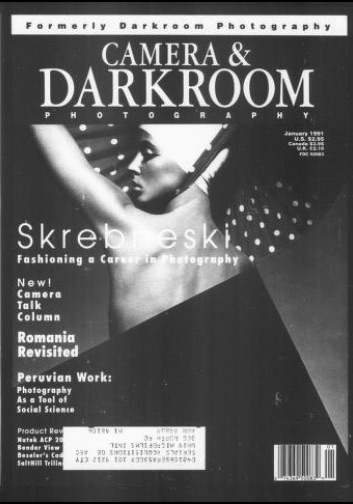
Camera & and Darkroom, January 1991, cover
Shortly after this collaboration began, in January of 1991, Darkroom Photography changed its name to Camera & Darkroom Photography — slightly expanding its nominal scope while clearly marketing itself as devoted to wet/chemical/analog photography. Nonetheless, its editors — Thom Harrop, at the point when I came on board, and later Ana Jones — envisioned it as a successor to what Jim Hughes had achieved, all too briefly, with Camera Arts in the 1980s: a large-circulation newsstand monthly about photography that would contain material of interest to a readership beyond the medium’s practitioners. As I understood it, they intended my presence therein as a signal in that regard.
At the juncture when the following article and its companion appeared, C&D struggled financially; indeed, it published its final issue in September 1995. Meanwhile, it grappled with the fact that photography as an evolving technology had begun to take an inexorable turn to the digital. Well-to-do middle-aged white men — a cohort that one fellow writer for C&D referred to as “doctors with cameras” — dominated the magazine’s readership. This demographic consisted in large part of analog diehards with their own darkrooms who wanted nothing to do with digital-imaging systems.

The Digital Evolution, A. D. Coleman, 1998
Because I chose to engage with the issues raised by digital imaging, I often bore the brunt of their displeasure, as expressed in angry letters to the editor. It seemed appropriate to respond to these “lips that touch digital will never touch mine” diatribes — some actually accompanied by subscription cancellations — with an explanation of my attention (and the magazine’s) to this technological and cultural leap. If this all seems quaint, indeed antiquated, that’s a measure of how far the technology (and we ourselves) have come in the past thirty years.
This article first appeared in my “Depth of Field” column in Camera & Darkroom, issue 16:6, June 1994. You’ll find it reprinted in my 1998 collection of essays, The Digital Evolution: Visual Communication in the Electronic Age. Click here for part 2. — A.D.C.]
•
The Final Image:
Some Thoughts on Electronic Imaging
Last spring — on the morning of Monday, May 24, 1993, to be precise — I was headed toward the International Center of Photography Midtown for a press conference on Montage 93, the then-upcoming “international festival of the image” that took place in Rochester, New York last summer. (For my report on Montage 93, see C&D, December 1993.)
![]() Anyhow, on the Staten Island Ferry that a.m. I picked up a Daily News that someone had left behind. (This is my John Cage-derived system for random newspaper reading, but that’s another story.) Browsing that tabloid, I came across a feature on a just-opened “electronic imaging center” in Manhattan. “On the second day of business at Final Image on the upper West Side, a customer brought in some beautiful wedding photographs — marred by a gardener raking leaves who happened to wander into the pictures,” it began.
Anyhow, on the Staten Island Ferry that a.m. I picked up a Daily News that someone had left behind. (This is my John Cage-derived system for random newspaper reading, but that’s another story.) Browsing that tabloid, I came across a feature on a just-opened “electronic imaging center” in Manhattan. “On the second day of business at Final Image on the upper West Side, a customer brought in some beautiful wedding photographs — marred by a gardener raking leaves who happened to wander into the pictures,” it began.
“Owner Oren Glick scanned the photos into a computer, and then, by manipulating the image using a mouse, removed the offending workman from the shot. The enthusiastic groom then asked Glick — as long as he was at it — to change the color of his bow tie and cummerbund from red to blue. No problem. In fact, he could even have replaced the bride. ‘We can do anything,’ enthuses [the 25-year-old] Glick . … ‘It’s magic!'”
I sat there in the respectful silence one reserves for historic moments marking major cultural change. So much for all our agonizing debates over the ethics of electronic image alteration in photojournalism, our ponderous ruminations about whether the editors at National Geographic should have moved those damn pyramids closer together. Vox pop had spoken, and its answer was: Go for it.
•
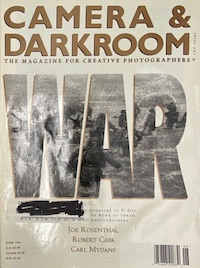
Camera & Darkroom, June 1994 (cover)
In passing, I referred to this epiphany a few columns back. The heated letters-to-the-editor dispute over our recent issue on electronic imagery, plus my own ongoing encounters with the new electronic forms of photography, led me to dig out the original news story and meditate on it awhile. And, as regular visitors to this column and my features might expect, I find myself of (at least) two minds on this complex subject. For I not only sympathize but empathize with those who find themselves unable to derive much pleasure or satisfaction from most of what’s currently being held up to us as exemplary of state-of-the-art lens-derived imagery in various pixelated forms.
Indeed, I’m perfectly willing (indeed, eager) to acknowledge that most of it is junk, and I am have all kinds of reservations and questions concerning the technology by which it’s generated, with which I’m still in many ways deeply uncomfortable. But the fact is that I have to disagree with those readers who claim that (a) this isn’t photography, (b) it isn’t even pertinent to photography, and (c) it certainly doesn’t belong in this magazine.
•
Insofar as (a) is concerned, over the past decade I’ve talked to a great many photographers who’ve made the transition from traditional photographic processes to electronic imaging. Whether it’s the venerable Todd Walker, who — with a solid grounding in silver-based and analine-dye photography, and with successful careers in advertising and creative photography under his belt — made the switch in his sixties (see C&D, September 1993) or a comparatively young sprat like Katrin Eismann, whose presentations at Montage 93 last summer emphasized the value of her education in traditional photographic methods at the Rochester Institute of Technology, they invariably sing a common refrain: Once you understand the analogies, everything you learned about lens-derived imagery from your experience with traditional photography translates directly into electronic imaging methods.
This suggests that, insofar as the actual production of imagery is concerned, there’s a direct evolutionary link between these technologies for visual communication that simply can’t be denied. We didn’t get to electronic imaging from painting; we got there from the lens-based media — still photography, video and film.
In regard to (b), it’s my belief that we do our minds the most service by casting our conceptual nets as widely as possible in looking for what might nourish our understandings of photography. As a working critic specializing in photography, I consider my purview to include not only traditional darkroom-based imagery in monochrome and color but negativeless forms like Polaroid 20x24s and SX-70s, “disembodied” forms such as slide projections, and, beyond those, photocollage, process experiment in photolithography, photo-silkscreen, holography, even photo-realist painting — and, certainly, electronically generated and/or manipulated imagery that’s in some way photographic. My premise is that an understanding of the specifics of photography — both the processes of production and our cultural relationship to the results — cannot help but prove useful in analyzing such work; and, conversely, that engaging with such work can only enrich my relationship to the specifics of the traditional photographic media.
•
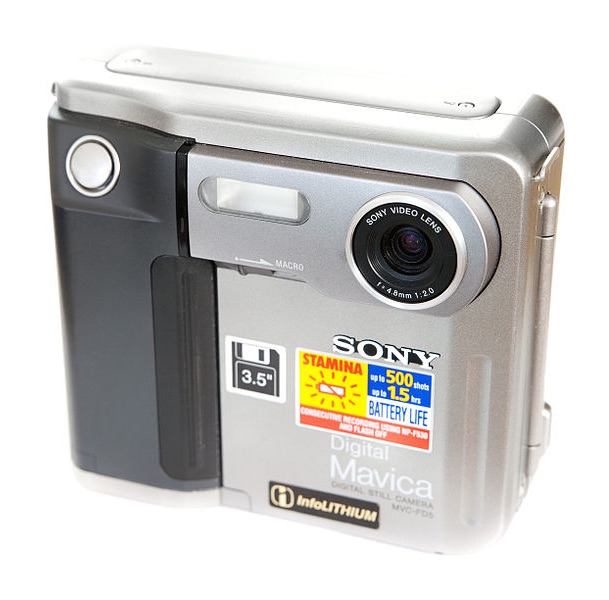
Sony Mavica FD5 4040. Photo courtesy Wikimedia Commons
Now, let me make it clear that I’m not speaking from the standpoint of an experienced performer within any of the visual media. I’m neither a working photographer nor a professional in electronic imaging. I can’t claim to have immersed myself in what the computer environment has to offer to picture-makers. Aside from the glimpses one gets and the flirtations one engages in at trade shows, my total hands-on experience to date with electronic imaging consists of an afternoon in which I got to play with a Sony Mavica, the electronic camera whose “negatives,” digitally encoded on 3-1/2 inch floppy diskettes, could be instantly called up on computer and incorporated into a newspaper’s page layouts, and a one-day introduction to Photoshop, during the course of which I violated copyright law by “capturing” my son Edward’s face from a photo I carry of him in my wallet and using it to replace the visage of the shaven-headed, shirtless, insect-covered beekeeper from Richard Avedon’s In the American West. (I gave it to Ed for his birthday; he loved it.) This hardly makes me a maven.
Nonetheless, the handwriting has been on the wall in this regard for a long time, and, if I may mix my metaphors, you haven’t needed to be a weatherman to know which way the wind has been blowing. Even an untrained outside observer like me could stick a wet finger into the breeze. Which brings me to (c), the question of why that discussion belongs in these pages.
•
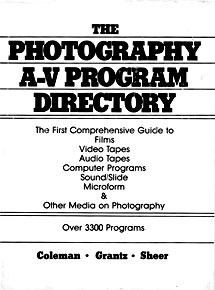
Coleman, Grantz, and Sheer, “The Photography A-V Program Directory” (1980), cover
As early as 1976 I was writing cautionary prophecies about the imminent transformation of our visual communication systems via electronic imaging. In 1980 my colleagues Douglas I. Sheer, Tricia Grantz and I published a resource book we’d worked on for several years, The Photography A-V Program Directory, listing over 3300 programs on photography in all current media: slide-sound, audiotape, film, videotape … and, yes, even way back then, a handful of computer programs. Now there are hundreds of such programs designed for photographers to use (a lot of them are freeware or shareware), even if they choose to work with the platinum print: programs for negative-file and print-file management, for all kinds of record-keeping, for exposure calculation, for control of enlargers during printing.
More and more cameras, accessories and darkroom equipment incorporate electronic control systems. Every year, the volume of photographic images by all kinds of photographers, living and dead, that is encoded on CD-ROM disks increases exponentially. Growing numbers of picture researchers, picture editors, art directors, photo historians and others retrieve and utilize these electronically encoded images. By the year 2000, it’s safe to say, only the most willfully stubborn and archaic among us will be eschewing on principle anything photographic that’s got electronics in it — and that’ll take some doing.
We don’t have to like these facts, but we do have to face them. There is no future for a photography journal that avoids this complex of issues. Erecting a sign over the entrance to this magazine that reads “Nothing electronic permitted past this point” is a sure way to doom the publication to a not-so-slow death. The audience for a magazine devoted, on principle, exclusively to forms of photography that originated before 1950 — many of which are essentially 19th-century — is not only limited but shrinking. Ten years from now there will barely be enough of them to support a bi-monthly newsletter.
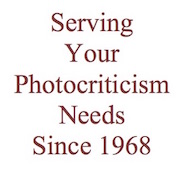 What’s more, despite the fact that my favorite form of photography remains the finely crafted, interpretive silver print, I don’t want to write for such an ostrich-minded readership; nor, I suspect, do most of my fellow contributors. Whatever our preferences and our anxieties, none of us can afford to close the door on the future.
What’s more, despite the fact that my favorite form of photography remains the finely crafted, interpretive silver print, I don’t want to write for such an ostrich-minded readership; nor, I suspect, do most of my fellow contributors. Whatever our preferences and our anxieties, none of us can afford to close the door on the future.
Electronic imaging is here to stay. Many of its variant systems are directly related to photography, and the troublesome nature of that relationship — the similarities and the differences as well — demands our critical attention, our analytic awareness. I can think of no place better than the pages of this magazine, whose readers are extremely knowledgeable concerning the preceding forms of lens-based imagery, to stage such a discussion. What better-informed or more critical audience could there be for that debate?
(Part 1 I 2)
•
This post supported in part by a donation from Carlyle T.
•

Special offer: If you want me to either continue pursuing a particular subject or give you a break and (for one post) write on a topic — my choice — other than the current main story, make a donation of $50 via the PayPal widget below, indicating your preference in a note accompanying your donation. I’ll credit you as that new post’s sponsor, and link to a website of your choosing.
And, as a bonus, I’ll send you a signed copy of my new book, poetic license / poetic justice — published under my full name, Allan Douglass Coleman, which I use for my creative writing.






Hi Allan,
it’s been a long time since our dinner in Arizona and I am sorry that I was unable to send my usual season’s greetings this year because there was no poetry in me since Bill was very ill and passed at 88 years old of covid pneumonia on January 16th. I have been making final arrangements and will be converting the studio to my living space ever since. I am attaching the ASMP obit link FYI. I enjoy your written pieces on photography keep them coming…
Best regards,
Cynthia
William Rivelli Has Passed – ASMP
So sorry to learn of Bill’s passing. He’ll be missed. Condolences to you and other family.
I don’t know if anyone has tracked our COVID losses in the photo field specifically or the visual arts more broadly. Should be done; just seeing a simple list of names would prove sobering. Might help people to realize that the fact that it’s become endemic doesn’t make it any less dangerous, especially for those of the senior persuasion.